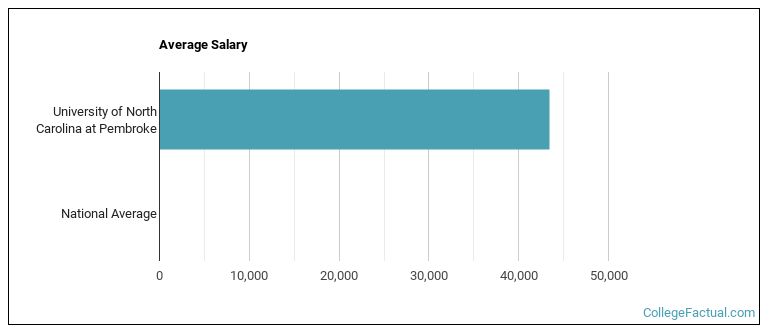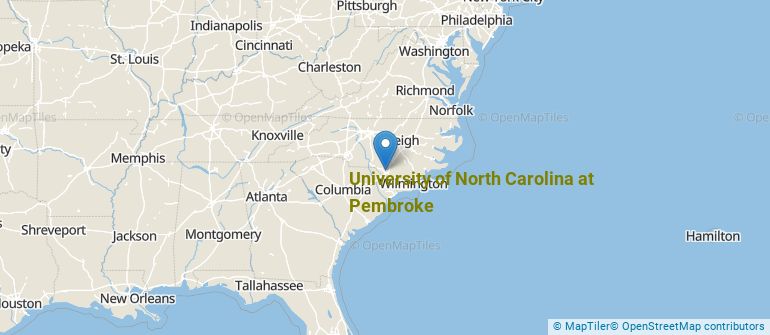 by our College Data Analytics Team
by our College Data Analytics TeamCollege Factual recognizes the best colleges and universities in its annual rankings. These rankings include categories for best overall colleges, best colleges for each major, best value schools, and much more.
University of North Carolina at Pembroke was awarded 68 badges in the 2025 rankings. The highest ranked major at the school is criminal justice & corrections.
Explore the best ranked schools for the programs you are most interested in.
According to College Factual's 2025 analysis, UNC Pembroke is ranked #1,484 out of 2,152 schools in the nation that were analyzed for overall quality. This is an improvement over the previous year, when UNC Pembroke held the #1,636 spot on the Best Overall Colleges list.
Out of the 93 colleges in North Carolina, UNC Pembroke is ranked at #48.
See all of the rankings for University of North Carolina at Pembroke.
With an acceptance rate of 90%, University of North Carolina at Pembroke is easier to get into than many other schools. But that doesn't mean you can slack off on your application. Make sure to treat this school like any other when submitting requested materials and documents.
About 1% of students accepted to UNC Pembroke submitted their SAT scores.UNC Pembroke received ACT scores from 1% of accepted students.
Learn more about University of North Carolina at Pembroke admissions.
The student to faculty ratio at University of North Carolina at Pembroke is about average at 14 to 1. This ratio is often used to gauge how many students might be in an average class and how much time professors will have to spend with their students on an individual level. The national average for this metric is 15 to 1.
In addition to the student to faculty ratio, some people look at what percentage of faculty members are full-time as a sign of how much time professors will be able to spend with their students. This is because part-time teachers may not be be on campus as much as their full-time counterparts.
The full-time faculty percentage at University of North Carolina at Pembroke is 75%. This is higher than the national average of 47%.
The freshmen retention rate tells us what percentage of first-year, full-time students choose to continue on to their sophomore year at a particular school. The rate at University of North Carolina at Pembroke is 72%, which is about average when compared to the national rate of 68%.
When we say that a student has graduated on time, we mean that they have finished their bachelor's degree within four years. The on-time graduation rate at UNC Pembroke is 23%. That's lower than the national rate of 33.3%
Find out more about the retention and graduation rates at University of North Carolina at Pembroke.
During the 2017-2018 academic year, there were 6,436 undergraduates at UNC Pembroke with 4,945 being full-time and 1,491 being part-time.
| $0-30 K | $30K-48K | $48-75 | $75-110K | $110K + |
|---|---|---|---|---|
| $6,130 | $7,521 | $10,006 | $13,008 | $13,217 |
The net price is calculated by adding tuition, room, board and other costs and subtracting financial aid.Note that the net price is typically less than the published for a school. For more information on the sticker price of UNC Pembroke, see our tuition and fees and room and board pages.
Almost 66% of college students who graduated with the class of 2018 took out student loans, but that percentage varies from school to school. At UNC Pembroke, approximately 51% of students took out student loans averaging $5,157 a year. That adds up to $20,628 over four years for those students.
Get more details about paying for University of North Carolina at Pembroke.

See which majors at University of North Carolina at Pembroke make the most money.
Get more details about the location of University of North Carolina at Pembroke.

Contact details for UNC Pembroke are given below.
| Contact Details | |
|---|---|
| Address: | One University Drive, Pembroke, NC 28372-1510 |
| Phone: | 910-521-6000 |
| Website: | https://www.uncp.edu/ |
| Most Popular Majors | Bachelor’s Degrees | Average Salary of Graduates |
|---|---|---|
| Business Administration & Management | 578 | $36,602 |
| Other Multi/Interdisciplinary Studies | 179 | $39,925 |
| Teacher Education Grade Specific | 152 | $42,973 |
| Criminal Justice & Corrections | 150 | $35,553 |
| Sociology | 144 | $34,051 |
| Social Work | 123 | $31,695 |
| General Biology | 105 | $30,147 |
| Health & Physical Education | 103 | $25,623 |
| Nursing | 77 | $73,906 |
| General Psychology | 67 | $28,209 |
Online learning options are becoming more and more popular at American colleges and universities. Online classes are great for students who have busy schedules or for those who just want to study on their own time.
In 2022-2023, 5,871 students took at least one online class at University of North Carolina at Pembroke. This is a decrease from the 6,316 students who took online classes the previous year.
| Year | Took at Least One Online Class | Took All Classes Online |
|---|---|---|
| 2022-2023 | 5,871 | 3,721 |
| 2021-2022 | 6,316 | 3,815 |
| 2020-2021 | 7,474 | 3,600 |
| 2018-2019 | 3,683 | 1,728 |
Learn more about online learning at University of North Carolina at Pembroke.
If you’re considering University of North Carolina at Pembroke, here are some more schools you may be interested in knowing more about.
Curious on how these schools stack up against UNC Pembroke? Pit them head to head with College Combat, our free interactive tool that lets you compare college on the features that matter most to you!
Footnotes
*The racial-ethnic minorities count is calculated by taking the total number of students and subtracting white students, international students, and students whose race/ethnicity was unknown. This number is then divided by the total number of students at the school to obtain the racial-ethnic minorities percentage.
References
More about our data sources and methodologies.